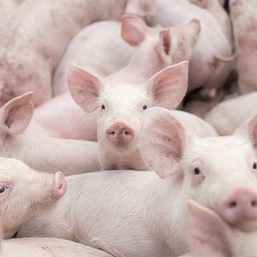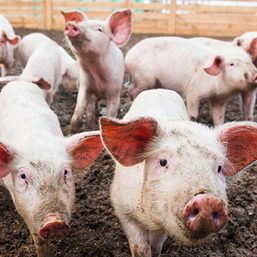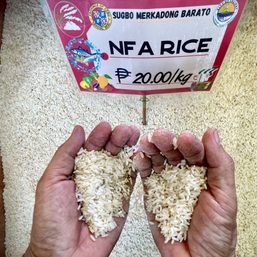SUMMARY
This is AI generated summarization, which may have errors. For context, always refer to the full article.
![[ANALYSIS] Why Duterte’s pork price ceilings backfired](https://www.rappler.com/tachyon/2021/02/pork-price-cap-February-12-2021.jpg)
Duterte and his men seem to have forgotten a lesson in basic economics, assuming they knew it at all.
To stifle the astronomic rise of pork prices (which even reached a whopping P400 a kilo in some places), President Rodrigo Duterte imposed 60-day price ceilings or caps in Metro Manila.
Executive Order 124, which he signed on February 1, capped the price of liempo (belly) to P300 a kilo, as well as the price of kasim (shoulder) and pigue (ham) to P270 a kilo. The price of dressed chicken was also set at no more than P160 a kilo, as more and more people switched away from pork.
As with all other types of price controls, Duterte’s price ceilings were motivated by good intentions, with the ordinary consumer supposedly in mind. Duterte’s executive order expressly stated that it is “imperative and urgent to ensure that basic necessities are adequate, affordable, and accessible to all.”
Yet the exact opposite happened.
In the first few days of the price ceilings’ implementation, pork essentially evaporated across Metro Manila’s wet markets. Stalls that remained open had little else to offer besides innards or low-quality pork, and the lucky few that had choice cuts invariably sold those at a loss. Many carinderias and other businesses relying on daily pork supplies closed earlier than usual; others couldn’t open at all.
Why did Duterte’s pork price ceilings seem to do more harm than good? It boils down to supply and demand.
Economics of price control
In January 2021, the country’s overall inflation rate (which measures how fast prices are rising) shot up to 4.2%. That’s the highest in nearly two years, and it simply means that prices of basic commodities are somehow accelerating again — right smack in the middle of a pandemic and a recession.
Certain prices ballooned far more than 4.2%, especially fresh pork prices which last month rose by a mind-boggling 68% and 77%, depending on the variety.
On the face of it, price caps seem reasonable enough as a response to skyrocketing prices. But all too often policymakers forget how price controls alter the incentives people face, and hence their behavior.
On the one hand, with an artificially lower price, there are slightly more consumers willing to buy pork than there ought to be. If pork should fetch P400 a kilo, some consumers turned off by that price might be induced to buy at the lower price cap of P300 a kilo.
At the same time, and much more importantly, pork producers’ incentives change dramatically.
If, say, the real cost of pork is P310 a kilo (as it actually was in one case) but producers could only sell at P300 by Duterte’s decree, they’d rather not sell at all. Otherwise, they would invariably suffer losses. Suppliers would rather deliver pork at places outside Metro Manila where prices are unconstrained.
The gap between consumer’s willingness to buy and producers’ unwillingness to sell invariably leads to a pork shortage. Any student in Econ 101 should have no trouble grasping and predicting this outcome.
Underlying problem
But in fact, hog producers aren’t so much unwilling to sell but unable to at all: for many of them, there’s literally nothing to sell.
African swine fever (ASF), the other pandemic that the Duterte government failed to contain, has decimated our pig population. By one private sector estimate, ASF could have wiped out as much as 36% of our pigs and counting. In January 2021, the country’s total hog inventory plummeted by 24% compared to the same period last year.
With surviving pig stocks requiring more or less the same amount of care and expense, producers are hard put to lower their prices — however much they want to help their buyers.
In sum, Duterte’s price ceilings made pork cheap but largely absent. Since it failed (and at any rate wasn’t designed) to address the underlying dearth of pig stocks, the price control policy wound up hurting the very people it intended to help.
As a way to control prices, it is about as effective as a king ordering the incoming tide to stay back.
In one news report, a pork retailer lamented that government seems to have failed to study the price ceilings and their effects, likening the situation to a researcher who came up with a title and a solution without first laying down a hypothesis and a conclusion.
What’s new with a government that has routinely failed at evidence-based policymaking for nearly 5 years?
What government can do
It seems obvious enough the Duterte government ought to do its best to grow the pig population, chiefly by coming to the aid of hog producers and helping them stop the further spread of ASF.
But that’s easier said than done. Unlike COVID-19, ASF has no vaccine yet, and new variants are being discovered abroad as we speak. It seems ASF will be with us for quite some time.
The next best thing is to beef up our pork imports. Indeed, the Department of Agriculture is already looking to triple the country’s pork imports, from 54,000 to 162,000 metric tons.
Considering, though, that the estimated shortage in 2020 totaled 516,000 metric tons, the projected influx of pork still won’t be nearly enough to meet current demand.
In addition, opening up to more imports will almost certainly be met by intense opposition from big hog producers and traders, who have grown used to the government’s import restrictions and would rather keep those to prop up the little profits they still enjoy.
But if it’s the welfare of consumers we’re looking after, there seems little choice now but to allow as many imports as possible — big producers and traders’ profits be damned.
Meanwhile, the Department of Agriculture has also begun transporting pork from the Visayas and Mindanao, and as a result some pork vendors in Metro Manila have reopened their stalls. Local governments are also waiving the rental fees of pork vendors in public markets. But these are all stopgap measures.
Quite laughably, at one point the Palace was reduced to simply pleading with pork producers to continue selling pork amid the price ceilings they themselves had imposed.
But government officials forget that producers are here to run businesses, not charities. And why should embattled businesses be forced to carry the government’s burden of ensuring food security for all?
‘Golden age of agriculture?’
Pork is just one problem now. Amid lesser but no less troubling shortages of vegetables, chicken, and other kinds of output, the agriculture sector in general seems to be in trouble.
As a result, Filipinos’ food security has been compromised, and absent urgent action heightened social unrest could ensue.
To address all this, the Duterte government is proposing to conduct a national food summit. This could help to, say, improve the coordination between various hog producers and traders nationwide, or better synchronize the planting and harvesting of various crops.
Yet some of the biggest problems in agriculture, as well as their solutions, are nothing new. You don’t need a summit to uncover them. At any rate, such a hastily organized event will do little to remedy decades of government neglect and underinvestment in agriculture.
The summit by the way also “aims to develop a National Food Security Plan to achieve our vision of a food-secure and resilient Philippines.” Why only now?
Former agriculture secretary Manny Piñol once trumpeted that the Duterte administration will be remembered as ushering in the “golden age of agriculture.” At the rate things are unfolding, though, it’s turning out to be anything but. – Rappler.com
JC Punongbayan is a PhD candidate and teaching fellow at the UP School of Economics. His views are independent of the views of his affiliations. Follow JC on Twitter (@jcpunongbayan) and Usapang Econ (usapangecon.com).
Add a comment
How does this make you feel?



![[ANALYSIS] A post mortem on the rice price ceiling](https://www.rappler.com/tachyon/2023/10/tl-riceceiling.jpg?resize=257%2C257&crop=245px%2C0px%2C720px%2C720px)
![[EDITORIAL] Talagang ‘ibang usapin ang bigas’](https://www.rappler.com/tachyon/2023/10/animated-rice-inflation-bbm-carousel.jpg?resize=257%2C257&crop_strategy=attention)
There are no comments yet. Add your comment to start the conversation.